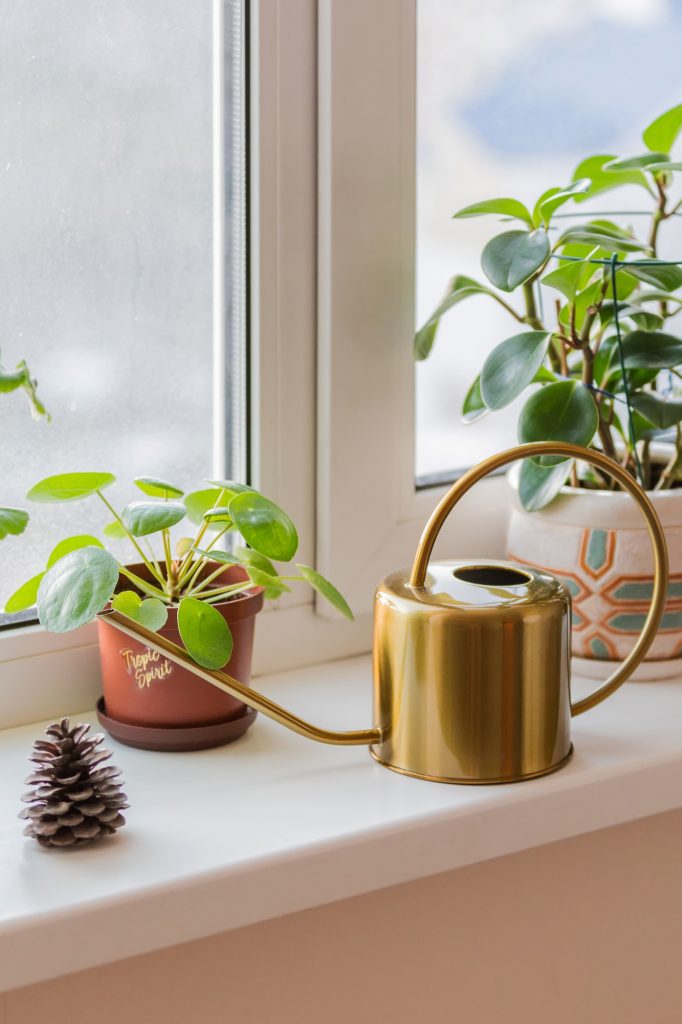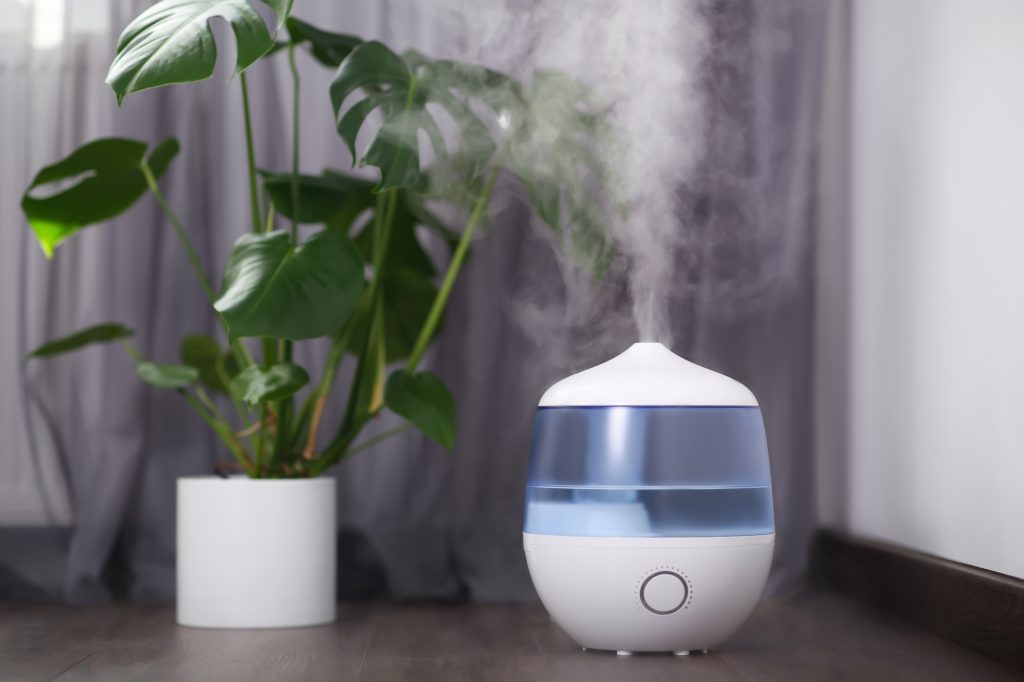Whether you’ve just brought home your first houseplant or trying to keep your indoor jungle from dying, there are some indoor plant tools that will boost your plant parent status to expert in no time.
Beyond a little love, water and a cute pot, there are a few things that you should keep on hand to help that brown thumb turn green.
The good news is that most items are pretty basic and can be found at second-hand stores, garage sales or cheaply on Amazon if you don’t want to wait another second to grow your collection.
You don’t need much for your indoor plants, but keeping up with their maintenance is the key to success.

(This post contains affiliate links, which means I may make a small commission if you click through and make a purchase.)
My biggest advice when it comes to caring for indoor potted plants is to have your items easily accessible so that you don’t forget to care for them when they need it (you’re on their schedule, not yours).
This means having your watering can, fertilizer and other items in plain view. This has been the biggest game changer in the health of my indoor plants because seeing these items on a daily basis is a great reminder to keep up with maintenance.
I recently found a cute floating shelf with a drawer to keep all my houseplant essentials readily available (but stashed away) and it’s such a great system.
13 Must Have Indoor Plant Tools
1. Long Spout Watering Can

While it seems obvious, the right type of watering device will make a world of difference for you and your potted plants. Choose one with a long spout which will help you be more precise in how you water.
For most indoor houseplants, it’s important to only water at the base of the plant or at soil level and not from above.
For example, you could cause damage and rot to your orchid by allowing the water to sit and stay trapped within the leaves.
And if you have a multi-stemmed plant like a Monstera, the long spout helps you reach down right to the soil.
My favorite watering can for indoor plants is this long spout copper one that also looks stylish on display when not in use.
2. Plant Mister or Spray Bottle

Most indoor houseplants will benefit from a little extra humidity, besides succulents and cacti of course.
If you’ve got tropicals or large houseplants, chances are the air in your home is probably too dry.
And generally speaking, most plants with broad leaves (think monsteras, fiddle leaf figs and even pothos) will benefit from a little mist every few days. At the very least, it helps keep the dust away which is important for optimum photosynthesis.
You can use an old spray bottle, but I prefer using a cute glass plant mister. Plus, they look adorable on your plant shelf, which helps serve as a reminder to mist your plants!
3. Pebble Tray for Humidity
Another way to provide your plants with a little extra humidity is to place a pebble tray underneath the pot. This mostly applies to plants like orchids or Calatheas.
Fill a saucer with pebbles (I like the white decorative ones) and then top it up with water. This will give an extra boost to the humidity in the air surrounding your plant.
4. Plant Humidifier

Now, if you own any tropical or humidity-loving plant, a plant humidifier is a must-have indoor plant tool. Especially if you’re headed out on vacation or going to be away for a few days.
I would even go as far to say that you might want to stay away from owning tropical houseplants unless you plan to use a humidifier (unless of course you live in a tropical climate).
I recommend this humidifier as it’s very quiet, and has a sensor to detect humidity levels so it doesn’t run constantly (plus it’s the highest rated one on Amazon).
5. Moisture Meter or Water Gauge

Along with sunlight, the right amount of water is essential to keeping a plant alive and healthy. You’ll likely fall into one of two categories, either over watering or underwatering your plants.
The best way to ensure your plant is ready for water is to use a moisture meter. They’re very affordable and can be found on Amazon, and it’s the easiest thing you can do to ensure thriving plants.
You can absolutely use your fingertip to check the soil, but the moisture meter takes the guesswork out of it and shows you right on the display when it’s ready for some water.
To really make it automated, you can invest in a wifi plant sensor so that you can check on the moisture levels from your phone anytime you want. Plus you can set up alerts to send to your phone to remind you when it needs water.
6. Fertilizer or Plant Food
If you’ve ever wondered how people have beautiful thriving plants in their homes, the secret is fertilizer.
Fertilizer not only helps your plants grow stronger, it helps keep them healthy and less susceptible to pests. It’s all the more important to feed indoor potted plants as their soil is limited and the nutrients can deplete more quickly compared to outdoor plants.
The easiest way to feed your plants is by using a slow release plant spike. This way you can just set it and forget it, until you need to change them out every 30 days in the summer and every 60 days in the winter. I have the best results when the stake is placed at the edge of the pot and not near the center or close to any plant stems.
More specifically, specialized plants like cacti and orchids need their own type of fertilizer, compared to an all-purpose houseplant fertilizer. The best place to pick up houseplant fertilizer is at your local greenhouse or garden center.
7. The Right Type of Pot

Choosing the right pot for your houseplant is very important for its health. Size and drainage are the most critical things to look for.
I recommend using terracotta or clay pots for most of your indoor plants. Not only are they the cheapest, they’re porous and moisture wicking, keeping excess moisture away from your plant.
And most come with a drainage hole and matching saucer, which is just as important. Plastic pots are ok as long as they have drainage holes.
However, when bringing home your plant from the greenhouse, most plants will prefer to be left in their nursery pots for some time while they adjust to their new home.
Repotting your plant right away can cause too much stress after already leaving its perfectly warm and sunny living quarters. You’ll know when it’s ready to be repotted when the roots start growing out the bottom.
8. Pruning Scissors or Indoor Gardening Shears
At some point in the life of your plant, you’ll want to snip off some stems here and there to either propagate it or encourage more growth.
Many plants also shed their bottom leaves as part of their lifecycle, so trimming will become part of regular maintenance. Regular haircuts can also encourage more growth, especially if you’re looking for a more full and dense plant.
When doing any kind of cutting on a plant, it’s important that the scissors, shears or razor blade is very sharp. You want to ensure the cleanest cut possible.
This is why I recommend using a designated pair of shears separate from regular old kitchen scissors.
Additionally, you should always sterilize your blade before you begin – isopropyl alcohol works perfect for this. It’s hard to find these days, but Amazon can usually deliver in a few days or less.
9. Repotting Tools (gloves, shovel, drainage discs)

The best part about bringing home new plants is to set them up in their new pots! Some indoor gardening essentials may seem obvious, like a small shovel and spade, but there are other other items you should consider as well.
First up, drainage discs. These are the perfect solution to preventing soil from coming out of the hole at the bottom of the pot, while allowing water to pass through.
If you’re going to be repotting or transplanting a cactus, a pair of thick gloves will keep you protected from the pokey spines.
Combine gloves with a pair of tongs and you will hopefully come out prick free!
For cacti, it’s also useful to have a plant brush on hand. You’ll notice when you repot them, dirt gets easily stuck in between the prickly spines and attaches like velcro. You can use a specific plant brush to clean them up, or a small toothbrush works too.

For minimal clean up, a repotting mat will keep your mess contained!
Better yet, grab this matching indoor plant tool set that comes with everything mentioned above.
10. Plant Support Tools (moss pole, velcro tape, bamboo stakes)

A good problem to have when owning plants is that they’ve started to become so big or tall that they need a little support!
As long as the growth is happening at a consistent pace (not tall and skinny meaning it’s reaching for the light), using plant supports will keep it thriving.
Choosing the right type of support varies for each plant.
Some plants prefer a bamboo stake, which are also great for building into a trellis.
A moss pole is a popular option for humidity loving plants like Monsteras and pothos. The moss keeps the roots and the stems moist, while providing extra texture for the plant to cling on to.
Other tall-growing plants, like the African Milk Tree, may benefit from some velcro plant tape to keep it intact.
11. Tools to Water Plants When You’re Away
Whether you’ll be away on vacation or are a forgetful, using watering globes can be a lifesaver for you and your plants. All you do is stick the spike end into the soil, and fill the globe with water.
No need to check the soil moisture level, just fill up the globe again when it’s empty.
Not only are these glass-blown watering globes beautiful, they’re the highest rated ones on Amazon.
Depending on the plant, the water should last about 5-7 days in these globes.

12. Pest Control
Unfortunately, houseplant pests are a reality most of us will have to face at some point in time.
Whether it’s mealybugs, spider mites or scale bugs, when you notice an infestation, it’s time to act fast for the best chance at getting rid of them.
I recommend keeping Neem oil and isopropyl alcohol (70% strength) in the house so that you’re prepared. Ideally, if you first notice the bugs when they’re small and they haven’t done much damage yet, I recommend applying neem oil to the plant.
It won’t hurt it, but it’s toxic to the little buggers. If there are more bugs than you thought, you can spray the plant with the isopropyl alcohol. I’d recommend diluting it with some water for the first application.
13. The Right Soil or Potting Mix
Finally, make sure you’ve got a high quality potting soil or medium for the types of plants you have. Many houseplants will just do fine in all purpose potting mix, but specialty plants need different living conditions.
Cacti and succulents like to be potted in fast draining soil that includes a mixture of sand, vermiculite, perlite and pumice.
Orchids can’t grow in soil, they need a specific potting medium like mulch and bark chips. Choosing a high quality soil is one of the best ways to prevent root rot on any plant.
Stay Green!



Very helpful! Thank you!